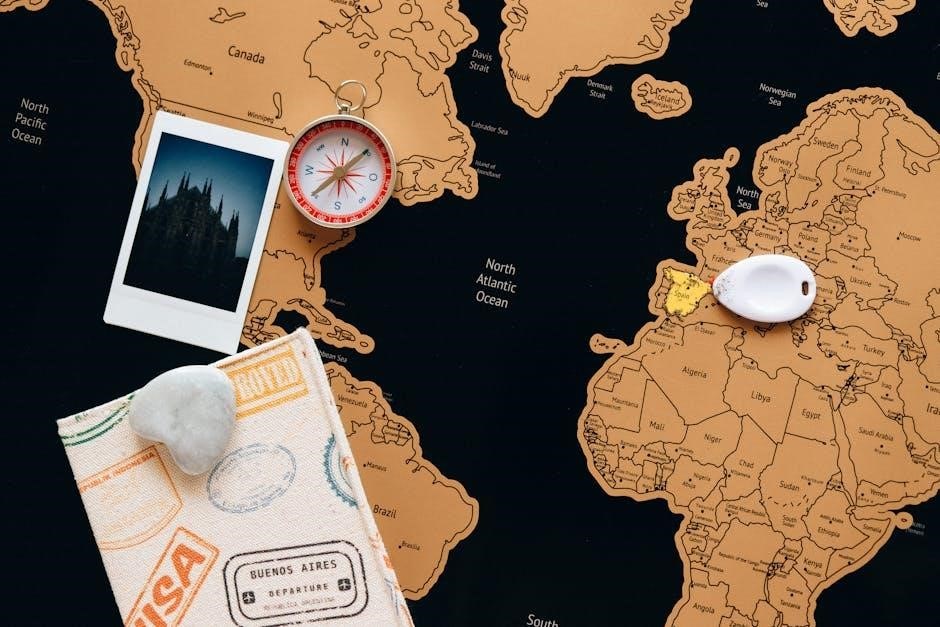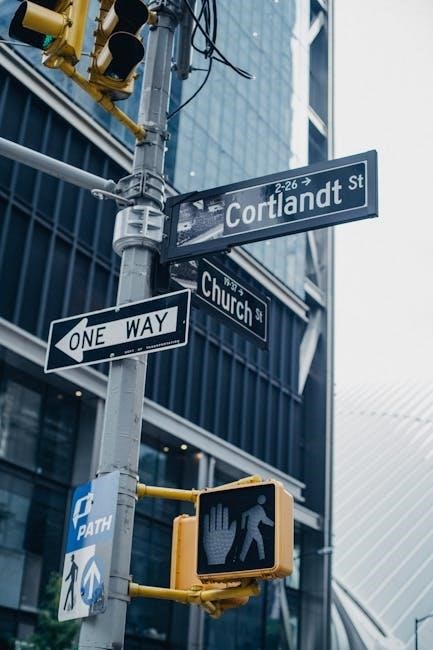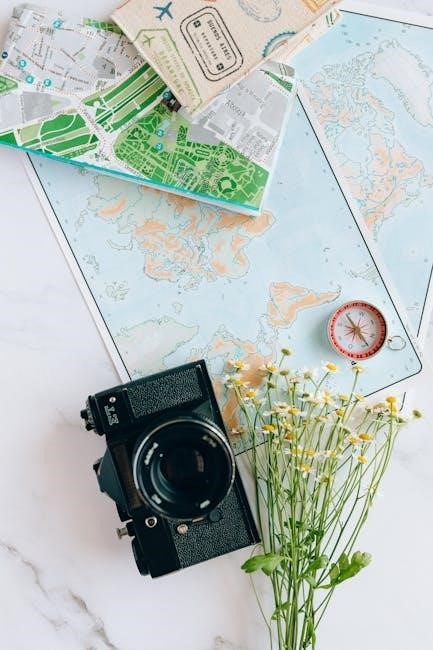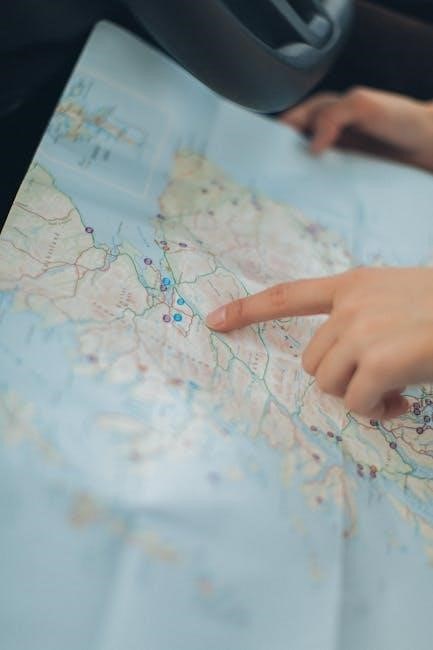Discover the perfect fit with Minnetonka’s size guide, designed to help you choose the right size for moccasins, boots, slippers, and sandals. Accurate measurements and a detailed size chart ensure comfort and style for every foot shape and preference.
Understanding Minnetonka Sizing
Minnetonka sizing is designed to provide a comfortable, natural fit. The brand offers a range of sizes to accommodate different foot shapes and preferences. For those who typically wear a half size, Minnetonka recommends sizing down to the nearest full size for the best fit. Their moccasins and slippers are known for their soft, malleable materials, which may stretch slightly over time. To ensure accuracy, it’s essential to measure your feet and compare them to the official Minnetonka size chart. This approach helps avoid sizing mismatches and ensures a comfortable, precise fit for any style or occasion.
- Measure feet flat-footed against a wall for accuracy.
- Consider the material’s stretch when choosing a size.
- Refer to the size chart for exact measurements.
How Minnetonka Sizes Compare to Other Brands
Minnetonka sizes tend to run slightly larger than other brands, offering a roomier fit. This is particularly noticeable in their moccasins and slippers, which are designed for comfort. For example, if you typically wear a size 8 in sneakers, you may find a size 7.5 in Minnetonka to be a better fit. The brand’s sizing is consistent across most styles, but materials like leather may stretch over time, affecting fit. Always refer to the official size chart for accuracy, and consider customer feedback for specific styles. This ensures you find the perfect balance between comfort and support.
- Minnetonka sizes are generally roomier than average.
- Leather styles may stretch slightly with wear.
- Check the size chart and customer reviews for guidance.
Importance of Finding the Right Fit
Finding the right fit is essential for comfort, support, and long-lasting wear. Ill-fitting footwear can lead to discomfort, blisters, or even foot fatigue. Minnetonka’s designs prioritize comfort, but only when the size is accurate. Proper fit ensures even weight distribution and prevents shoes from slipping or feeling too tight. For styles like moccasins or boots, a well-fitting pair enhances durability and performance. Investing time in measuring and selecting the correct size ensures a better user experience and extends the life of your footwear. A perfect fit also guarantees the intended aesthetic and functional benefits of each design.
- Proper fit enhances comfort and reduces discomfort.
- Incorrect sizing can lead to foot fatigue or blisters.
- A well-fitting pair ensures durability and performance.

Measuring Your Foot for the Perfect Fit
Accurate foot measurement ensures a comfortable, proper fit. Use a ruler on flat ground, trace your foot outline, and measure length and width carefully for precision.
- Measure both feet to account for size differences.
- Stand while measuring for accurate foot expansion.
Step-by-Step Guide to Measuring Foot Length
To measure foot length accurately, start by placing your foot on a flat surface with weight evenly distributed. Trace the outline of your foot on paper, ensuring the pen is held perpendicular. Measure the longest distance from the back of the heel to the tip of the longest toe using a ruler. Record the measurement in inches or centimeters. For precision, measure both feet, as they may differ slightly, and use the longer measurement. Stand while measuring to account for foot expansion. This method ensures a reliable baseline for selecting the correct Minnetonka size. For added accuracy, consider using a Brannock device.
How to Measure Foot Width Accurately
To measure foot width accurately, stand on a flat surface and trace the outline of your foot on paper. Place the paper on a hard surface and use a ruler or flexible measuring tape to find the widest part of your foot, typically across the ball. Measure the distance between the two furthest points. For precision, repeat the process for both feet, as width may vary. Use the wider measurement to ensure comfort. When converting to Minnetonka sizes, refer to their size chart, which often includes width options. This step ensures a proper fit and avoids tightness or excess space.
Tips for Measuring Your Feet at Home
Tips for Measuring Your Feet at Home
For accurate foot measurement at home, stand on a flat, hard surface wearing the same type of socks you plan to wear with your Minnetonka footwear. Use a flexible ruler or measuring tape to ensure the foot lies flat. Trace your foot on paper placed on the floor to capture the outline accurately. Measure both feet, as sizes can differ slightly. For the best fit, consider the time of day, as feet tend to swell slightly by afternoon. Use these measurements to align with Minnetonka’s size chart, ensuring comfort and proper fit without tightness or excessive space.

Common Sizing Challenges and Solutions
Addressing half sizes, foot width variations, and style-specific fits ensures comfort. Opt for size charts, customer reviews, and material stretch considerations to overcome sizing obstacles effectively.
What to Do If You Wear a Half Size
If you wear a half size, Minnetonka recommends rounding up to the next full size for the best fit. This ensures comfort and avoids tightness. For example, if you’re a size 7.5, opt for an 8. However, consider the style: soft-soled shoes may stretch slightly, while boots offer a snugger fit. Using insoles or thick socks can also help customize the fit. Always check the size chart and customer reviews for specific styles, as some may run slightly larger or smaller. This approach ensures comfort and prevents sizing issues.
How to Choose the Right Size for Narrow or Wide Feet
For narrow feet, opt for styles with a snug fit, such as Minnetonka’s moccasins, which naturally conform to slimmer foot shapes. Wide feet benefit from roomier styles like boots or sandals with adjustable laces. Measure your foot width to ensure accuracy, and consult the size chart for specific style measurements. If unsure, consider ordering a size up for wide feet or down for narrow feet. Soft-soled shoes may stretch slightly over time, offering a comfortable fit. Always check customer reviews for insights on how a particular style fits different foot widths.
Understanding Size Variations Across Different Styles
Minnetonka sizes can vary slightly across different styles due to design and material differences. For example, moccasins may fit snugly, while boots offer more room. Soft-soled styles tend to stretch over time, whereas hard-soled shoes maintain their shape. Check the size chart specific to each style, as measurements may differ. Pay attention to customer reviews for insights into how a particular style fits. If unsure, consider ordering a size up for roomier styles or down for tighter fits. Always prioritize comfort and functionality based on the intended use of the footwear.

Material-Specific Sizing Considerations
- Leather styles may stretch over time, requiring a snug initial fit.
- Suede and fabric shoes tend to fit differently than leather.
- Some materials, like soft deerskin, offer more flexibility and comfort.

How Leather Stretch Affects Sizing
Leather is a natural material that stretches over time, which can impact sizing. Minnetonka leather shoes may feel snug initially but will mold to your foot shape with wear. This means it’s important to choose a size that fits well but isn’t too tight, as the leather will relax. Different leather types, like soft deerskin or hardened suede, stretch at varying rates. To ensure the best fit, try shoes in the afternoon, as feet tend to swell during the day. Wearing the same thickness of socks as you plan to use regularly can also help. Proper fit is key for comfort and durability.

Sizing Differences Between Moccasins and Boots
Moccasins and boots from Minnetonka often have slight sizing differences due to their designs. Moccasins are typically softer and more flexible, fitting closely around the foot, while boots have sturdier structures and may require more room for comfort. The heel and ankle support in boots can also affect how they fit compared to moccasins. It’s important to try both styles on or refer to the size chart specific to each type. Additionally, moccasins may stretch more over time, while boots tend to maintain their shape. Choosing the right size depends on your foot shape and whether you plan to wear socks. Proper fit ensures optimal comfort and support.
Why Fabric and Suede Styles May Fit Differently
Fabric and suede Minnetonka styles may fit differently due to material properties. Fabric shoes, like canvas or textile, are often more pliable and may stretch slightly over time, offering a snug yet adaptable fit. Suede styles, while soft, tend to hold their shape more firmly and may not stretch as much. The thickness of the material can also impact fit, with suede sometimes feeling more structured. To ensure the best fit, consider the material’s flexibility and your foot shape. Thicker materials may require sizing up for comfort, while thinner fabrics may fit true to size.

Seasonal and Lifestyle-Specific Sizing Tips
Seasonal and lifestyle needs influence Minnetonka sizing. Winter styles may require thicker socks, while summer shoes fit best with lightweight wear. Outdoor activities demand durable sizing.
Winter Boot Sizing vs. Summer Shoe Sizing
Winter boots and summer shoes have distinct sizing considerations due to differences in design and usage. Winter boots often require a slightly larger size to accommodate thicker socks and insulation, ensuring warmth and comfort. Summer shoes, like sandals or slip-ons, typically fit more snugly, as they are worn with lightweight or no socks. Seasonal activities also play a role; winter boots may need to handle snow and rugged terrain, while summer styles prioritize breathability. Measure your feet before ordering, as seasonal needs can affect your ideal size. Consider width and comfort for extended wear during outdoor adventures or casual outings.
How to Size for Comfort in Different Weather Conditions
Weather conditions significantly impact foot comfort, influencing sizing choices; In hot weather, feet tend to swell, so opt for a slightly roomier fit to prevent blisters. For colder conditions, prioritize warmth and moisture-wicking materials to keep feet dry and comfortable. In wet conditions, ensure your footwear is waterproof or water-resistant to avoid discomfort. Consider activities and terrain, as rugged environments may require sturdier styles. Measure feet at the end of the day to account for natural swelling. Always choose styles with cushioning and support for long-lasting comfort, regardless of the weather.
Sizing for Outdoor Activities vs. Casual Wear
When choosing sizes for outdoor activities versus casual wear, consider the demands of each. Outdoor activities often require more support and durability, so opting for a snug, secure fit is essential to prevent slipping during movement. For casual wear, prioritize comfort and flexibility, allowing for a slightly roomier fit to accommodate daily wear. Sturdy outsoles and ankle support are key for outdoor styles, while soft, breathable materials are ideal for casual settings. Measure your feet for both scenarios to ensure the best fit, as activity level and footwear purpose can affect sizing needs. Always prioritize comfort and functionality for your intended use.

Customer Reviews and Feedback on Sizing
Customers often praise Minnetonka’s consistent sizing, with many noting accurate fits. Some highlight that sizes run true to standard measurements, while others mention occasional variations across styles.
Common Themes in Customer Size Reviews
Customers frequently highlight that Minnetonka sizing runs true to size, with many praising the consistency across different styles. Comfort and quality are often mentioned as key positives. However, some users with wider feet note that certain styles, like moccasins, can feel snug. Leather styles are noted to stretch slightly over time, which may affect fit for those with narrower feet. The return policy is also a common theme, with many appreciating the ease of exchanging sizes if needed. Overall, reviews suggest that while sizing is generally reliable, personal foot shape and style can influence the fit.
How to Use Customer Feedback to Choose Your Size
Customer feedback is a valuable resource for determining your Minnetonka size. Look for patterns in reviews, such as whether shoes run true to size, small, or large. Pay attention to comments about comfort, width, and how styles fit different foot shapes. If multiple users mention a style runs narrow, consider sizing up. Use the size chart as a baseline but adjust based on feedback. Reading reviews from users with similar foot types can also help you make an informed decision. This approach ensures a better fit and reduces the likelihood of needing returns or exchanges.
Real-Life Experiences with Minnetonka Sizing
Many customers share their experiences with Minnetonka sizing, highlighting both successes and challenges. Some report finding their perfect fit effortlessly, while others note that certain styles run slightly smaller or larger than expected. For example, one customer mentioned that their moccasins fit perfectly but had to size up for boots. Another appreciated the soft leather stretch in sandals but found ankle boots snug. These real-life stories emphasize the importance of considering style-specific sizing variations. By learning from others’ experiences, you can make more informed decisions when selecting your size, ensuring a comfortable and satisfying fit.

Minnetonka Size Chart and Conversion
Minnetonka offers a detailed size chart with international conversions, ensuring accurate fit for all styles. The chart includes measurements in inches and centimeters, aiding global customers in selecting the best fit.
Detailed Minnetonka Size Chart for All Styles
Detailed Minnetonka Size Chart for All Styles
Minnetonka’s size chart provides precise measurements for all styles, from moccasins to boots and sandals. It includes foot length in inches and centimeters, ensuring accuracy for every shoe type. The chart caters to both men’s and women’s sizes, offering a clear comparison to help customers choose the right fit. Additionally, it highlights half sizes and width options, addressing diverse foot shapes. Users can align their foot measurements with the chart to determine their best fit, ensuring comfort and proper sizing across all Minnetonka collections.
Converting International Sizes to Minnetonka Sizes
Converting international sizes to Minnetonka sizes is straightforward with their official size chart. Minnetonka offers a detailed conversion guide for customers worldwide, ensuring accurate sizing. For example, a US women’s size 8 often corresponds to a European size 38 or a UK size 6; The chart includes measurements in inches and centimeters, making it easy to compare. By aligning your local size with Minnetonka’s sizing system, you can avoid mismatches. Always cross-reference your foot length with the chart for the most accurate fit.
- Use Minnetonka’s conversion table for precise sizing.
How to Use the Size Chart for the Best Fit
To ensure the best fit, start by measuring your foot length and width accurately. Match these measurements to Minnetonka’s size chart, which provides precise sizing in inches and centimeters. Consider your foot shape—narrow, standard, or wide—to choose the most comfortable style. Note that some styles, like moccasins, may run slightly different from boots. Always refer to the chart specific to the style you’re purchasing, as sizing can vary. Double-checking ensures your selected size aligns with your measurements for optimal comfort and fit.
- Measure both feet to account for size differences.

Return and Exchange Policies for Size Issues
Minnetonka offers a 30-day return policy for size issues. Items must be unused with original tags. Returns can be exchanged or refunded. Shipping costs may apply.
Minnetonka’s Return and Exchange Policy
Minnetonka offers a flexible return and exchange policy to ensure customer satisfaction. Items can be returned within 30 days of purchase for a full refund or exchange. Products must be in original condition with tags intact. Return shipping costs are the responsibility of the customer, but Minnetonka provides a prepaid return label for exchanges. Refunds are issued in the original payment method, while exchanges are processed based on availability. If an item is damaged or defective, Minnetonka may cover return shipping. This policy allows customers to find the perfect fit without hassle, ensuring a smooth and satisfactory experience;
How to Initiate a Size-Related Return
To initiate a size-related return, visit Minnetonka’s website and log into your account. Navigate to the “Orders” section and select the item you wish to return. Follow the prompts to print a return shipping label. Package the item in its original condition with tags attached. Ship the item back using the provided label. Allow 5-7 business days for processing. Refunds or exchanges will be handled based on availability. For exchanges, a prepaid return label may be included. Ensure all steps are completed within 30 days of delivery to qualify for a return or exchange.
Tips for Avoiding the Need for Returns
Tips for Avoiding the Need for Returns
To avoid size-related returns, carefully review Minnetonka’s size chart and measure your feet accurately before ordering. Consider your foot shape—narrow, medium, or wide—and compare it to the style’s fit description. Read customer reviews for insights into how a particular shoe runs. Order your usual size unless the style is known to fit differently. Try shoes on in the afternoon, as feet tend to swell during the day. Wear the same type of socks you plan to use with the shoes. Double-check the size and style before finalizing your order to ensure the best fit.
Accurate measurement, style consideration, and size chart alignment ensure the best fit. Prioritize comfort and functionality based on lifestyle for optimal satisfaction with Minnetonka footwear.
Minnetonka sizing varies by style, material, and season. Accurate foot measurement is crucial, and considering width, leather stretch, and weather conditions ensures comfort. Narrow or wide feet may require size adjustments, while customer reviews offer valuable insights. Using the size chart and understanding international conversions helps avoid returns; Prioritize functionality for outdoor activities and opt for slightly larger sizes in boots. Proper fit enhances durability and comfort, making it worthwhile to invest time in selecting the right size for your lifestyle and needs.
Final Tips for Ensuring the Best Fit
For the best fit, prioritize comfort and functionality based on your lifestyle. Try shoes in the afternoon, as feet swell during the day. Consider sock thickness, especially for boots. Order multiple sizes to compare and return the ones that don’t fit. For leather styles, allow a break-in period for optimal comfort. A good fit should feel right from the start but improve over time. Lastly, consult customer reviews for real-life experiences to guide your decision. These steps ensure you find the perfect pair for lasting comfort and satisfaction.